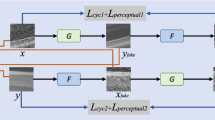Abstract
Optical coherence tomography (OCT) has received increasing attention in the diagnosis of ophthalmic diseases due to its non-invasive character. However, the speckle noise associated with the low-coherence interferometric imaging modality has considerably negative influence on its clinical application. Moreover, the lack of clean and corresponding noisy OCT image pairs makes it difficult for supervised learning-based approaches to achieve satisfactory denoising results. Therefore, inspired by the idea of disentangled representation and generative adversarial network (GAN), we propose an unsupervised OCT image speckle reduction algorithm which firstly disentangles the noisy image into content and noise spaces by corresponding encoders. Then the generator is used to predict denoised OCT image only with the extracted content features. In addition, the pure noise patches which are cut from the noisy image are utilized to ensure a purer disentanglement. Extensive experiments have been conducted and the results suggest that our proposed method demonstrates competitive performance with respect to other state-of-the-art approaches.
Access this chapter
Tax calculation will be finalised at checkout
Purchases are for personal use only
Similar content being viewed by others
References
Drexler, W., Morgner, U., Ghanta, R.K., Kärtner, F.X., Schuman, J.S., Fujimoto, J.G.: Ultrahigh-resolution ophthalmic optical coherence tomography. Nat. Med. 7(4), 502–507 (2001)
Amini, Z., Rabbani, H.: Classification of medical image modeling methods: a review. Curr. Med. Imaging Rev. 12(2), 130–148 (2016)
Gong, G., Zhang, H., Yao, M.: Speckle noise reduction algorithm with total variation regularization in optical coherence tomography. Opt. Express 23(19), 24699–24712 (2015)
Xu, J., et al.: Wavelet domain compounding for speckle reduction in optical coherence tomography. J. Biomed. Opt. 18(9), 096002 (2013)
Pircher, M., Götzinger, E., Leitgeb, R.A., Fercher, A.F., Hitzenberger, C.K.: Speckle reduction in optical coherence tomography by frequency compounding. J. Biomed. Opt. 8(3), 565–570 (2003)
Klein, T., André, R., Wieser, W., Pfeiffer, T., Huber, R.: Joint aperture detection for speckle reduction and increased collection efficiency in ophthalmic mhz oct. Biomed. Opti. Express 4(4), 619–634 (2013)
Adabi, S., et al.: Learnable despeckling framework for optical coherence tomography images. J. Biomed. Opt. 23(1), 016013 (2018)
Aum, J., Kim, J., Jeong, J.: Effective speckle noise suppression in optical coherence tomography images using nonlocal means denoising filter with double Gaussian anisotropic kernels. Appl. Opt. 54(13), D43–D50 (2015)
Chong, B., Zhu, Y.K.: Speckle reduction in optical coherence tomography images of human finger skin by wavelet modified BM3D filter. Opt. Commun. 291, 461–469 (2013)
Li, M., Idoughi, R., Choudhury, B., Heidrich, W.: Statistical model for oct image denoising. Biomed. Opt. Express 8(9), 3903–3917 (2017)
Mayer, M.A., Borsdorf, A., Wagner, M., Hornegger, J., Mardin, C.Y., Tornow, R.P.: Wavelet denoising of multiframe optical coherence tomography data. Biomed. Opt. Express 3(3), 572–589 (2012)
Zaki, F., Wang, Y., Su, H., Yuan, X., Liu, X.: Noise adaptive wavelet thresholding for speckle noise removal in optical coherence tomography. Biomed. Opt. Express 8(5), 2720–2731 (2017)
Abbasi, A., Monadjemi, A., Fang, L., Rabbani, H.: Optical coherence tomography retinal image reconstruction via nonlocal weighted sparse representation. J. Biomed. Opt. 23(3), 036011 (2018)
Xie, J., Xu, L., Chen, E.: Image denoising and inpainting with deep neural networks. In: Advances in Neural Information Processing Systems, p. 1 (2012)
Zhang, K., Zuo, W., Chen, Y., Meng, D., Zhang, L.: Beyond a gaussian denoiser: residual learning of deep CNN for image denoising. IEEE Trans. Image Process. 26(7), 3142–3155 (2017)
Ma, Y., Chen, X., Zhu, W., Cheng, X., Xiang, D., Shi, F.: Speckle noise reduction in optical coherence tomography images based on edge-sensitive cGAN. Biomed. Opt. Express 9(11), 5129–5146 (2018)
Halupka, K.J., et al.: Retinal optical coherence tomography image enhancement via deep learning. Biomed. Opt. Express 9(12), 6205–6221 (2018)
Huang, Y., et al.: Simultaneous denoising and super-resolution of optical coherence tomography images based on generative adversarial network. Opt. Express 27(9), 12289–12307 (2019)
Devalla, S.K., et al.: A deep learning approach to denoise optical coherence tomography images of the optic nerve head. Sci. Rep. 9(1), 1–13 (2019)
Zhu, J.Y., Park, T., Isola, P., Efros, A.A.: Unpaired image-to-image translation using cycle-consistent adversarial networks. In: Proceedings of the IEEE International Conference on Computer Vision, pp. 2223–2232 (2017)
Fang, L., Li, S., Nie, Q., Izatt, J.A., Toth, C.A., Farsiu, S.: Sparsity based denoising of spectral domain optical coherence tomography images. Biomed. Opt. Express 3(5), 927–942 (2012)
Fang, L., et al.: Fast acquisition and reconstruction of optical coherence tomography images via sparse representation. IEEE Trans. Med. Imaging 32(11), 2034–2049 (2013)
Guo, Y., et al.: Structure-aware noise reduction generative adversarial network for optical coherence tomography image. In: Fu, H., Garvin, M.K., MacGillivray, T., Xu, Y., Zheng, Y. (eds.) OMIA 2019. LNCS, vol. 11855, pp. 9–17. Springer, Cham (2019). https://doi.org/10.1007/978-3-030-32956-3_2
Acknowledgement
This work was supported by National Natural Science Foundation of China under Grant 61671312, 61922029.
Author information
Authors and Affiliations
Corresponding author
Editor information
Editors and Affiliations
1 Electronic supplementary material
Below is the link to the electronic supplementary material.
Rights and permissions
Copyright information
© 2020 Springer Nature Switzerland AG
About this paper
Cite this paper
Huang, Y. et al. (2020). Disentanglement Network for Unsupervised Speckle Reduction of Optical Coherence Tomography Images. In: Martel, A.L., et al. Medical Image Computing and Computer Assisted Intervention – MICCAI 2020. MICCAI 2020. Lecture Notes in Computer Science(), vol 12265. Springer, Cham. https://doi.org/10.1007/978-3-030-59722-1_65
Download citation
DOI: https://doi.org/10.1007/978-3-030-59722-1_65
Published:
Publisher Name: Springer, Cham
Print ISBN: 978-3-030-59721-4
Online ISBN: 978-3-030-59722-1
eBook Packages: Computer ScienceComputer Science (R0)





